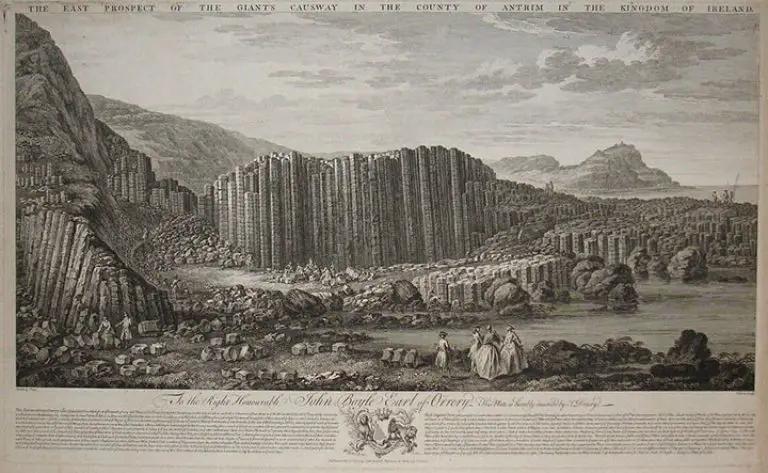Table of Contents
Add a header to begin generating the table of contents
The Giants Causeway was said to be discovered in 1692 when William King, the then Anglican Bishop of Derry and future Archbishop of Dublin, along with an unnamed Cambridge Scholar, or Master of Arts, visited the area.
As with many discoveries at this time, they are often attributed to those who first publish their findings. However, the Causeway had been known to locals for a considerable time before the Bishops visit in old Irish as Clochan na bhFomharaigh meaning the “Stepping Stones of the Fomorians. The Fomorians were said to be a small dark people who inhabited Ireland before the Celts.
First Visitors
The first recorded reference to it is a brief mention in a letter by Sir Richard Bulkeley (d. 1710) to Dr Lister in 1693, subsequently published in the Philosophical Transactions of the Royal Society, London. However, Bulkeley had not visited the Causeway himself and was relying on the observations of the Bishop of Derry and ‘a master of arts in Cambridge’.
Bulkeley raised a series of questions concerning the nature of the Causeway’ pillars’, and these were answered in an account of the Giant’s Causeway by Bishop Samuel Foley (1655 – 1695) in 1694, again published in the Philosophical Transactions, accompanied by an engraving from an original drawing by Christopher Cole.

Bishop Foley’s brief note was immediately followed in the same 1694 volume of the Philosophical Transactions by a second article on the Giant’s Causeway by a certain Thomas Molyneux (1661 – 1733), a founder member of the Dublin Society in June 1731. Again, Molyneux did not visit the Causeway but was commenting on the information laid before him in Dublin. Although Cole’s drawing (above) shows the Grand Causeway columns, it is highly stylised and Molyneux, through the then Dublin Philosophical Society, commissioned artist Edwin Sandys to make a more realistic attempt.

An engraving of Sandys’ drawing was subsequently published in the Philosophical Transactions of 1697 by Thomas’ older brother William (1656 – 1698; who himself had founded the Dublin Philosophical Society in 1683), which was referred to in an article on the Causeway by Tomas the following year.
In 1740, the Society offered £25 art premiums and a then-unknown Dublin artist, Susanna Drury, submitted canvasses of the Giant’s Causeway (below) which she had painted during a three-month stay in Antrim. She was awarded a premium, and her paintings were subsequently engraved in London by Francois Vivarès and eventually found their way across Europe.

In 1765, Volume 12 of the great French Encyclopédie was published containing an article on the ‘Pave des geans’ and used one of Drury’s engravings as an illustration. This was followed in 1768 by a volume of plates for the Encyclopédie, containing Drury’s ‘East prospect of the Giant’s Causeway’ next to similar columns of the Auvergne region (below). The captions for these illustrations were written by French geologist Nicolas Desmarest, who had concluded that the Auvergne columns were volcanic in origin.

From Drury’s engravings, he immediately makes the same connection. Thus Nicolas Desmarest is generally accredited with suggesting that the Giant’s Causeway originally formed from erupting volcanic lava, even though he had never actually seen it!
Controversy – Neptune Versus Pluto
Desmarest’s proposal that columnar basalts, such as those in the Auvergne and Giant’s Causeway, had erupted from volcanoes triggered controversy within the fledgeling science of geology which rumbled on for over half a century.
Two entrenched sides developed, one supporting the new idea which became known as Plutonism, the others remaining staunchly behind the generally accepted view at that time, known as Neptunism.
Neptunists
Neptunists followed the ideas of Abraham Gottlob Werner (1749 – 1817) of Freiburg, who proposed that when the Earth first formed, it had been covered by a vast ‘Primaeval Ocean’. As the ocean gradually receded, all the rocks we see around us today crystallised out from the ocean waters. Coal deposits burning underground could erupt some of their black material onto the surface as basalts.
Looking at the black rocks at Portrush, their arguments are understandable; the basalts contained abundant fossils called ammonites, which were taken as evidence for submarine deposition.
Plutonists
Plutonists followed the ‘theory’ proposed by the Edinburgh doctor, James Hutton (1726 – 1797) which first appeared in 1785. Hutton saw the planet in a state of dynamic cyclicity. Mountains were continually eroded and the sedimentary products deposited at the bottom of the oceans.
These would be buried and become rock layers. At depth, they became heated, deformed and pushed back up to the surface to begin another cycle. Hutton’s ideas were revolutionary for two reasons; firstly, he could see, ‘no vestige of a beginning and no prospect of an end’ to the geological history of Earth. Secondly, that the planet had a source of internal heat which heated rocks and in some places could melt them, sending this melt to the surface to erupt from volcanoes.
In the curious case of the Portrush ammonites, vulcanists suggested that the hard black rocks were not basalts at all, but were mudstones that had been baked by the great heat of an intrusion that was pushed up from deep within the Earth.

Portrush Black Rock
The Portrush Rock (Sadly not the sweet kind that keeps dentists in fancy cars) is now a National Nature Reserve, and it’s well worth a visit. It is on the shoreline by the Ramore Head Car Park, facing East Strand Beach. The nearby Portrush Coastal Zone has a wealth of information on the natural and local history of the Causeway Coast from Portrush to Ballycastle.

The Reverand Dr William Hamilton
Finally, in 1784, a keen geologist investigated the Antrim coast.
The Reverend Doctor William Hamilton (1755 – 1797) wrote the first accurate account of the geology of the Antrim Coast as a series of letters to the Earl of Charlemont during 1784, which were subsequently published as a book in 1786. Hamilton’s book puts forward a lucid argument in favour of the volcanic origin of the Causeway.
Considering that he was writing before Hutton’s ‘Theory of the Earth’ had been presented, historians should perhaps give Hamilton more credit for his work.

William Hamilton was also responsible for founding the Museum at Trinity College Dublin in 1777 and was one of the founders of the Royal Irish Academy in 1785. Sadly, Hamilton was murdered during the local unrest leading up to the 1798 rebellion. However, his book on the Causeway Coast remained the benchmark reference on the area long after his death and a second edition were published in 1822.
Today, ‘Hamilton’s Seat’ overlooking Benbane Head commemorates the site where he is said to have often rested while out on horse-back investigating the geology along this stretch of coast.

The First Guidebooks and Travel Writers
In 1788, the Complete Irish Traveller in the Kingdom of Ireland was published in two volumes. This was one of the first popular guidebooks to be published and contained an excellent description of the giant’s Causeway.

In 1788, the Complete Irish Traveller in the Kingdom of Ireland was published in two volumes. This was one of the first popular guidebooks to be published and contained an excellent description of the giant’s Causeway.
Guidebooks flourished throughout the 1830s and 1840s, by which time the Causeway was on almost every traveller to Irelands itinerary (much like today’s tourists). These guidebooks and articles in magazines such as the Dublin Penny Journal and the Illustrated London News featured images and stories of the famous stones.

Naturalists, many travelling in Naturalist club trips, gathered information from the ever-increasing number of geological journals and prints were anxious to see the famous Giant’s Causeway and develop their new-found knowledge. Also, the fledgeling past time of photography was contributing to the interest in the site. Prints were first published in the mid-1800s, and by the end of the century, photographs were appearing regularly in guidebooks, alongside the more traditional engravings and sketches.

